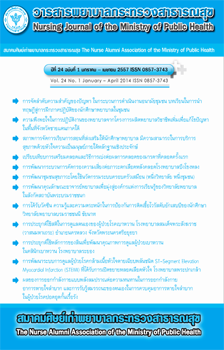เปรียบเทียบการเตรียมคลอดและวิธีการเบ่งต่อผลการคลอด ของมารดาที่คลอดครั้งแรก
Main Article Content
Abstract
การวิจัยเชิงทดลองแบบสุ่มและมีกลุ่มควบคุมใช้วิธีการปกปิดแบบทางเดียว เพื่อเปรียบเทียบผลการคลอด จากการเตรียมคลอด และวิธีการเบ่งที่แตกต่างกันของมารดาที่คลอดครั้งแรก จับฉลากสุ่มตัวอย่างเข้ากลุ่ม 3 กลุ่ม กลุ่มละ 33 – 34 รายกลุ่มควบคุมได้รับการเตรียมคลอดตามมาตรฐานของโรงพยาบาล กลุ่มทดลอง 1 ได้รับการเตรียมคลอดด้วยการฝึกเบ่งแบบวัลซัลวาและกลุ่มทดลอง 2 ได้รับการเตรียมคลอดด้วยการฝึกเบ่ง แบบเปิดกล่องเสียง เครื่องมือในการดำเนินการวิจัยคือ แผ่นพับประกอบแผนการสอน และเครื่องมือในการเก็บ รวบรวมข้อมูลคือ แบบบันทึกข้อมูลทั่วไป ข้อมูลการคลอดแบบประเมินคะแนนแอพการ์ และแบบสังเกตทักษะ การเบ่งคลอดพบว่าผลการคลอดของทั้ง 3 กลุ่มแตกต่างกันอย่างไม่มีนัยสำคัญทางสถิติ (p>0.05) แต่กลุ่ม ควบคุมมีความไม่สุขสบายและอาการผิดปกติขณะคลอดมากที่สุด นอกจากนี้กลุ่มควบคุมมีคะแนนทักษะการเบ่ง ในระยะคลอดน้อยกว่ากลุ่มทดลองอย่างมีนัยสำคัญทางสถิติ (p<0.01) 3 ประการ คือ 1) เบ่งคลอดถูกวิธี 2) เบ่ง นาน 6 วินาที และ 3) เบ่งซ้ำ 3 – 4 ครั้งจนกว่ามดลูกคลายตัว ผลการทดลองเป็นการยืนยันความรู้ความเข้าใจ เกี่ยวกับธรรมชาติของการเบ่งคลอดโดยทั้ง 3 กลุ่มใช้วิธีการเบ่งแบบวัลซัลวาร่วมกับการเบ่งแบบเปิดกล่องเสียง แต่กลุ่มควบคุมมีการปนกันของวิธีการเบ่งมากที่สุด ดังนั้น ผลการวิจัยนี้สามารถใช้เป็นแนวทางในการพัฒนาการ เตรียมคลอดเกี่ยวกับวิธีการเบ่ง เพื่อให้เกิดผลการคลอดที่ดีแก่ผู้คลอดต่อไป
Comparison of Childbirth Preparation and Pushing Technique toward Birth Outcomes among Nulliparous Women
Piyarat SomSripang*
Sommapat Sornchai**
Abstract
A randomized control trial (RCT) using the single blind technique was conducted to compare the birth outcomes of different childbirth preparation and pushing techniques among nulliparous women. The participants were randomly placed into three groups, each group consisted of 33- 34 nulliparous women. The control group received a hospital standard protocol. The first experimental group was trained to use the valsalva pushing technique. The second experimental group was trained to use the opened glottis pushing technique. The research tools comprised a teaching plan and data collection form on which demographic data, labor information and Apgar score were recorded. Pushing skill was also observed and recorded. The results showed statistically no significant differences in birth outcomes among those three groups (p>0.05), but the control group had the highest discomfort and abnormal symptoms at birth. The control group had a significantly lower score of pushing skill compared with the two experimental groups (p<0.01), which consisted of 1) correct pushing technique, 2) controlling breathing using 6 second intervals, and 3) repeat pushing three or four times until uterine contractions cease. The findings of this study confirm an understanding about the nature of labour pushing. All 3 sample groups had a combined pushing technique of valsalva and opened glottis. However, the control group seemed to use a combined pushing technique more than the two experimental groups. The results of this study can be used to develop guidelines for childbirth preparation and pushing technique to achieve the best birth outcome.
* Registered Nures , SakonNakhon Hospital
** Assistant Professor, KhonKaen University
Article Details
บทความและรายงานวิจัยในวารสารพยาบาลกระทรวงสาธารณสุข เป็นความคิดเห็นของ ผู้เขียน มิใช่ของคณะผู้จัดทำ และมิใช่ความรับผิดชอบของสมาคมศิษย์เก่าพยาบาลกระทรวงสาธารณสุข ซึ่งสามารถนำไปอ้างอิงได้

